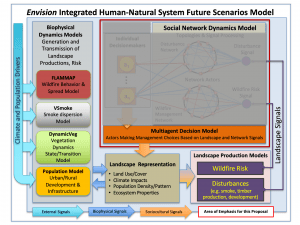At the simulation modeling heart of our proposal is Envision, an innovative multi-paradigm modeling framework designed to support analysis of SESs in time and space1, 2 (Figure 1). Fundamental to Envision’s architecture is the concept of “plug-in models” that provide a high degree of modularity, integration, and flexibility in model representations. Envision has been used for integrated modeling of a variety of distinct SESs, e.g., climate impacts on water availability in Oregon3 and Idaho4, agricultural dynamics in Ontario, Canada5, wildfire response to climate and policy in central Oregon2, climate-related coastal community planning6, wildlife and open space planning in Oregon’s Portland Metro area7, climate-fire-development-ecosystem interactions8-11 and ecohydrologic analyses12 in Oregon’s Eugene-Springfield WUI, and others.

Figure 1. The coupled SES simulation modeling system used in Envision, emphasizing full spectrum of coupled submodels.
Citations
- Bone, C., et al., A Temporal Variant-Invariant Validation Approach for Agent-based Models of Landscape Dynamics. Transactions in GIS, 2014. 18(2): p. 161-182.
- Spies, T.A., et al., Examining fire-prone forest landscapes as coupled human and natural systems. Ecology and Society, 2014. 19(3): p. Article 9.
- Jaeger W, et al., Anticipating Water Scarcity with Climate Change in the U.S. Pacific Northwest Using a Landscape Model of a Coupled Natural-Human System. 2014, World Congress of Environmental and Resource Economists.
- Inouye, A.M., Development of a hydrologic model to explore the impacts of future climate on water resources in the Big Wood Basin, Idaho, in Water Resource Engineering, M.S. Thesis, Editor. 2014, Oregon State University: Corvallis, OR. p. 89.
- Waldick, R., et al., Mainstreaming Climate Change: Integrated landscape assessment, decision support process, and toolkit. 2014, International Institute for Sustainable Development. p. 92.
- Mills, A.K., Exploring the Impacts of Climate and Management on Coastal Community Vulnerability through Alternative Future Scenarios, in M.S. of Water Resource Engineering Thesis. 2015, Oregon State University: Corvallis, OR.
- Penteado, H., Open Space as an Armature for Urban Expansion: A Future Scenarios Study to Assess the Effects of Spatial Concepts on Wildlife Populations. 2012, Ph.D. Dissertation Department of Landscape Architecture, University of Oregon: Eugene, OR. p. 183.
- Hulse, D., et al., Anticipating surprise: Using agent-based alternative futures simulation modeling to identify and map surprising fires in the Willamette Valley, Oregon USA. Landscape and Urban Planning, 2016. 156: p. 26-43.
- Johnson, B.R., et al., Simulating mechanistic wildfire behavior in response to fine-grained landowner management and climate change. In Preparation.
- Johnson, B.R., et al., Climate change and landowner behavior cast uncertainty on wildfire impacts to the wildland-urban interface. In Preparation.
- Johnson, B.R., et al., Anticipatory Planning: Imagining the future to alter its course. In Preparation.
- Wu, H., et al., A scenario-based approach to integrating flow-ecology research with watershed development planning. Landscape and Urban Planning, 2015. 144: p. 74-89.